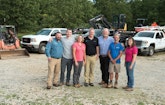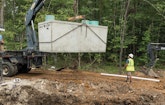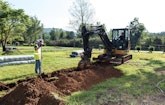
Technicians Josh Wright, left, and Preston Johnson use a Sim/Tech Filter TruCore sludge sampler to measure solids in a septic tank during a service call.
Before becoming a passion, doing weekend percolation tests and drawing onsite designs in CAD for an engineer was an additional revenue source for David Meints. He worked in various fields as an industrial engineer in Arkansas.
When his part-time labors became lucrative, Meints earned his designated representative license in 1996 (Arkansas Department of Health certification for percolation tests, system designs and inspections) and opened MEINCO in Alexander, just southwest of Little Rock, the state capital. Although still a part-time business, revenue doubled each year. In 2000, his wife, René Meints, traded her day job for full-time work in the company.
In 2001, the couple incorporated the now full-time business as MEINCO Septic Systems and branched into installations. Nine years later, they added a maintenance division and changed the company’s name to MEINCO Wastewater Services. “When the Arkansas Department of Environmental Quality mandated National Pollutant Discharge Elimination System permits, homeowners with package treatment units were forced to hire a Class II wastewater operator and a service provider to remain compliant,” David Meints says. “I have both licenses.”
Today, the $1.4 million company has one crew installing 75 to 100 systems annually, another crew servicing 450 maintenance contracts totaling 1,200 to 1,500 yearly visits, and two office assistants.
LEADING BY EXAMPLE
In the 2000s, Saline and Pulaski counties each issued 250 to 400 septic permits annually, but half the designers on the state health department designated representative list were retired or semiretired. “I took the projects no one else wanted and learned from them,” Meints says.
A degree in industrial management helped him develop his business model. According to Sam Dunn, health department senior environmental health specialist, it is unique to the state. “People are watching and trying to emulate David’s model,” Dunn says.
Meints work philosophy drives the model. He still tweaks or fixes systems he installed 20 years ago. “I take responsibility for everything I touch,” he says. “That gets around.” Health department personnel and environmental health specialists also know he will troubleshoot problems with them or mentor newcomers.
Nevertheless, Meints has a problem; and Dio Vannucci, with Cornerstone Home Lending, identified it as economies of scale — obtaining larger production returns through division of labor. In other words, until Meints relinquishes responsibility to qualified individuals, the company will run him instead of the other way around. “Once you don’t have to show up for work and the company still makes money, then you’ve made it,” Vannucci tells him.
Meints is willing to surround himself with more accomplished people, but they cost money. “Where am I going to get it?” he asks. “What do 500 more service customers look like?”
Meints’ ace in the hole has always been his wife and business partner, the person on whom he leans when making decisions. “René is correct more times than not,” he says. “When I don’t listen, I venture into something I shouldn’t have.” His wife is a certified designated representative, installer, service provider, Class III operator (IV is highest) and registered sanitarian, and she graduated magna cum laude with a degree in health science.
KNOWLEDGE IS POWER
Education is another major component of Meints’ business model, for it exposes technicians to new technologies or helps them remain current. He insists his employees are licensed by the state and certified by manufacturers. Before hiring someone, he asks how easily the individual learns and would he or she be comfortable traveling to various vendors around the country to get certified on their products. Those anxious to expand their knowledge find a good home with the company.
“I’m willing to risk training possible future employees for my competition versus having employees who can’t answer customers’ questions,” he says. “The first time my guys changed out a programmable logic unit on an Orenco MVP control panel without me standing there was worth whatever I spent to get them to that point.”
Meints practices what he preaches. In May 2019, he earned a Master of Science in crop, soil and environmental science from the University of Arkansas. The degree evolved from meetings he attended in which half the people in the room held professional licenses or degrees and the other half lacked knowledge. Being in the latter group didn’t suit him.
In 2012, Meints earned his professional soil classifier license, but the state classes were limited in scope. Realizing he wasn’t done learning, Meints spent five years in the master’s course. “I’m overqualified to design, install or service wastewater systems, but I’m no longer plagued by questions I had in 2012,” he says. “What I learned enables me to push the limits of soil and know when to tell clients I can’t help them.
“Learning how to say no is a big milestone in business,” he continues. “If you say yes and fail, that’s all people remember. If you tell them what they are asking is unrealistic and explain why, they’ll respect that.”
TOP OF HIS GAME
Education also produced a bolder Meints who, over the last 10 years, has accepted projects that pushed him out of his three-bedroom comfort zone. His first 3,000-gpd design-install was for a recreational vehicle park in Alexander, but that is not why he remembers the 2009 job.
“René and I were trading off excavating trenches and laying chambers,” he says. “She was overheated and exhausted but refused to stop working. I realized if we wanted to continue growing, we couldn’t go on like this or we’d kill each other. That year I hired my first employee.” His son, David Meints II, owner of Enviro-Tech Solutions, acts as engineer of record.
Three years later, the senior Meints tackled a complex, two-prong design-install project totaling 5,000 gpd for a marina and resort. The owner wanted to add 14 cabins and seven mobile home sites, but the existing septic system was failing and too close to the lake. The system also collected septage pumped from houseboat holding tanks.
For the first phase, Meints installed a solids containment basin next to a restaurant to collect wastewater from the building and marina. A pump sent wastewater 2,000 feet to three 1,500-gallon tanks in series: a primary tank, settling tank with two AquaWorx Remediators (Infiltrator Water Technologies), and a dose tank feeding seven 60-foot-long trenches of EQ-26 chambers (Infiltrator Water Technologies).
For phase two, a tank at each cabin or mobile home pad sent effluent to a centralized 4,500-gallon recirculation tank. Wastewater from the tank gravity-fed to an AX100 AdvanTex textile filter unit (Orenco Systems), which was plumbed for a second AX100 if needed. Treated effluent flowed to a 1,500-gallon dose tank pressurizing a 20,000-square-foot dripfield in four equal zones.
“This was a large field for me,” Meints says. “I developed and mounted my own tool on the excavator to plow in the tubing a row at a time. Now we have a Ditch Witch 410 vibratory plow.”
STRETCHING THE IMAGINATION
As work evolved, so did the company’s dynamics. Today, 75% of installs are for new construction, with 80% residential and 20% commercial. Installations generate 50% of annual revenue, while design and maintenance contracts average 25% each. (The contract renewal rate is 95%.) Effluent disposal is 50-50 dripfields or surface discharge with NPDES permit. The latter produced a memorable case.
In 2016, wastewater backed up into the local animal shelter, and effluent from the 3,000-gpd treatment plant with surface discharge was noncompliant. The system had a 10,000-gallon aerated primary clarifier gravity-feeding a 10,000-gallon secondary clarifier next to the building’s side door. Staff walked dogs around this tank.
When Meints arrived, he was stunned to see a mat of dog hair and debris in the secondary clarifier thick enough to foster a 6-foot-tall tree growing through the protective grates. The tank, in constant flood stage, pushed water through the pressure manifolds in the sand filter. In addition, someone had dug up the bed and replaced the 1.25-inch pipes with 3-inch pipes.
He removed the grates and used his Kubota KX121 compact excavator to extract the top mat. After the clarifier settled a little, he called a pumper who emptied both tanks in seven trips. Meanwhile, Meints repaired the return activated sludge pump, jetted the laterals, added pumps to pressurize them, and installed a control panel to manage flows and return activated sludge. The system is functioning as originally designed.
SETTING NEW GOALS
As revenue permitted, the couple built an office on their 3 acres and converted an 864-square-foot barn into a shop. Today, besides the equipment already mentioned, Meints owns three GMC trucks, three AGL lasers (GeoMax), a John Deere 60G compact excavator and Kubota machines: a KX040 excavator and SVL75 skid-steer. He hired Terri Belvins as his administrative assistant and part-time service provider in 2015.
Yet one item has been slow to change: When soils don’t meet standards for subsurface disposal, regulations still defer to surface discharge. “Arkansas doesn’t have empirical data on secondary treated effluent and how it would behave in reduced drainfields,” Meints says. “The topic became the research for my master’s thesis because I had access to the customers, infrastructure and unsuitable soils. Whatever the data showed, it would be something no one else had done in the state.”
His conclusions have initiated conversations in health departments and opened minds. For example, Terry Paul, Arkansas Department of Health branch chief of Environmental Health and Protection, asked him to look at a challenging site with suitable soils but limited disposal areas. Paul wondered if a reduced drainfield would be applicable.
Meints’ next goal is to hit $1.5 million in sales. “Adding two more employees this year for a second half service-half installation crew will help secure 500 more maintenance contracts,” he says. “Then I’ll keep growing until they become a dedicated service crew.”
Time to learn
The septic code in Arkansas requires the bare minimum — four hours — of continuing education for license renewals. David and René Meints, owners of MEINCO Wastewater Services, believe designated representatives should have the same amount of continuing education as wastewater operators.
The couple noticed a jump in company sales and projects after implementing what they learned from their first Education Day year ago at the Pumper & Cleaner Environmental Expo (now the Water & Wastewater Equipment, Treatment & Transport Show). “I can link my confidence and the ability to do my job to those classes and continuing education through NOWRA (National Onsite Wastewater Recycling Association), NEHA (National Environmental Health Association) and the WWETT Show,” David Meints says.
Since 2014, the couple has taken their employees to local trade shows and the WWETT Show. “At the 2018 WWETT Show, Philip Johnson and Preston Johnson (no relation), who had been with us for less than 18 months, had enough knowledge to hold their own at roundtable sessions,” Meints says.
For Meints, the ripples from education spread far. “I encourage my peers to attend national and local trade shows,” he says. “Those who invest in themselves reap the returns.”











